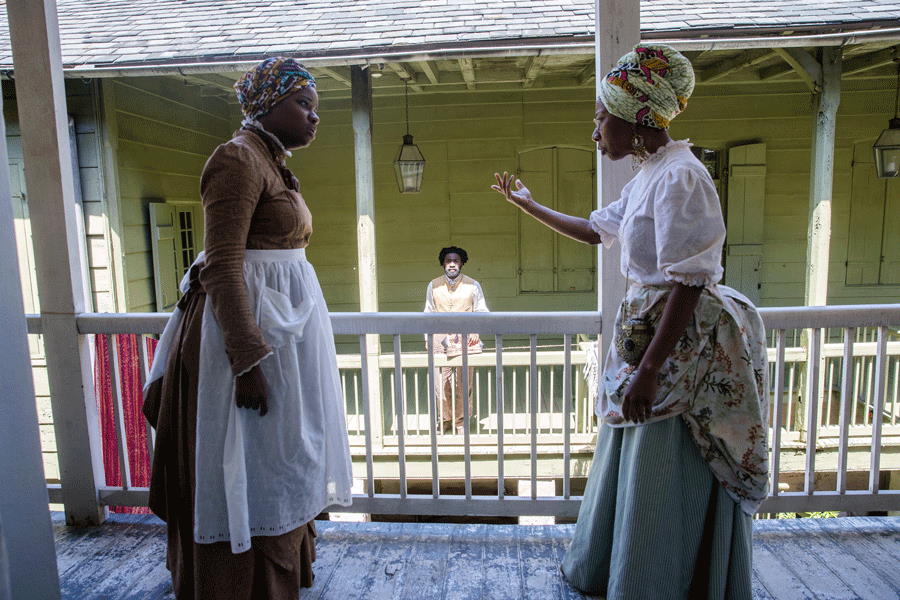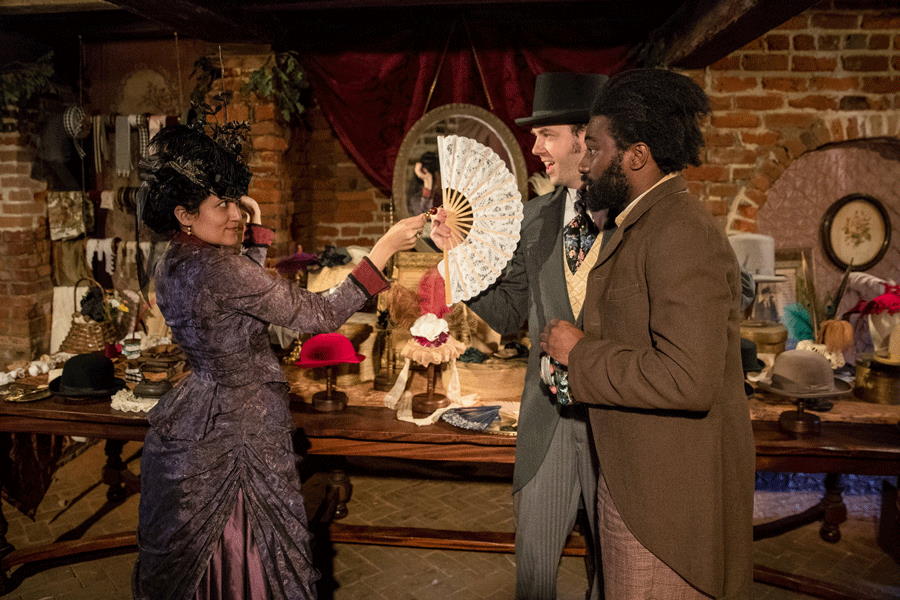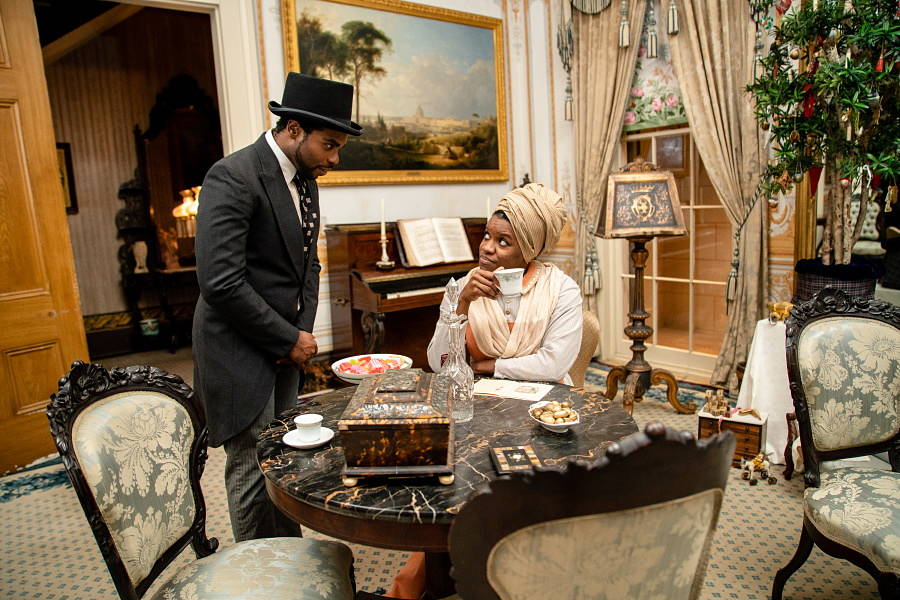It’s 3:45 p.m. on Sunday, Jan. 5, not even one week into this chaotic new decade, and I’m walking into Gallier House, the elegantly restored 19th-century residence-turned-museum at 1132 Royal Street in New Orleans’s French Quarter. I’m here to watch a rehearsal of The Uninvited, the latest work by the award-winning performance ensemble Goat in the Road Productions, led by 38-year-old co-artistic director Chris Kaminstein.
Kaminstein, a tall, lanky fellow with a full brown beard and an amiable smile, is nowhere to be seen, but several cast and crew members are passing through the gift shop that serves as the house’s entrance gallery, speaking mostly in whispers. A radio newscaster, though, is clearly audible: Things are neck and neck, he announces breathlessly, Saints 20, Vikings 20, and the game is going into overtime. Actor Ian Hoch is leaning stone-still against a cabinet wall, his head buried in his arms.
I’ve arrived at a tense moment, it’s clear—the NFC championship game, precursor to the Super Bowl, is in its climactic moments a mile or so away in the Superdome, giving this rehearsal a vivid subtext. Moments later, the standoff is over. There are some anguished shouts from the adjacent courtyard. Hoch finally moves, sliding down the wall to slump into a chair, expressionless.
The Saints have lost.
It’s an unexpected blow to a city that loves its sports teams as much as it does its own meandering, checkered history, which predates the country’s founding by nearly a century. In The Uninvited, a significant but distressingly obscure slice of that history—the post-Civil War Reconstruction Era, roughly 1867-77—is under rigorous theatrical examination. The piece is the second in a planned four-part series of site-specific, immersive, original dramas about racial justice—or, more accurately, the lack thereof—in the decade after the abolition of slavery.
The first production in the series, last season’s much-lauded The Stranger Disease, channeled spectators through the halls and stairwells of another room-where-it-happened locale, a 232-year-old French Colonial house museum known as Madame John’s Legacy, situated two-and-a-half blocks from Gallier House, on Dumaine Street. With its rending and funny exploration of interracial love amid the deadly yellow fever epidemic of the 1870s, The Stranger Disease packed Madame John’s with rapt spectators and went on to sweep last year’s Big Easy Theatre Awards, winning accolades for best play, best director, best ensemble, and best original work—the equivalent, maybe, of a shutout on the football field. Is a repeat of that success in the offing?
Kaminstein shows up a few minutes later in the gift shop—which, I’ve learned in the interim, doubled as the entryway to a soda-and-mineral-water-bottling factory back in the middle of the 19th century, when prominent architect James Gallier Jr. and his family moved onto the property—to squire me through a walled courtyard into the grand old house’s ornate, wool-carpeted double parlor, where a second run-through of the show is beginning. Any residual agitation among the cast about the Saints’ Super Bowl disqualification has evaporated, and like the curious audiences who will patronize The Uninvited when it opens next week, I take on the role of an attentive fly upon the wall, free to buzz wherever I like through the multi-story house, absorbing its plush, antique atmosphere as I follow the interactions of nine characters. Some, like Gallier’s feisty widow Aglae (played by company co-artistic director Shannon Flaherty) and her teenage daughters (Darci Jens Fulcher and Grace Kennedy), are based on real-life figures; others, like Aglae’s savvy, rebellious cook Charity (April Louise), have been imagined by the writers. The action occurs over the course of a single momentous afternoon in December 1874.
On the historic day in question, some six years after Gallier’s death left Aglae sole mistress of the property, a virtual riot broke out along Royal Street when a cadre of young men from the anti-integration Crescent City White League attempted to forcibly segregate a girls’ school at the LaLaurie Mansion, two doors down from the Gallier home. The battle spilled into the household in the person of a Mr. Jarvis (played in the aforementioned Hoch, whose bio boasts 60-plus local performances), friend of the family and, alas, an investigating officer from the League. None of the nine souls in Gallier House, white or black, young or old, would finish the day unscathed.

“I’ve become an amateur historian on the time period of these projects,” Kaminstein tells me a few days later in a post-opening double interview with his co-director and main writing partner, Kiyoko McCrae, a theatre- and filmmaker who served in recent years as managing director of Junebug Productions, the New Orleans-based company widely praised for its focus on and support of African American culture in the Black South. As lead writers, Kaminstein and McCrae share team credits for The Uninvited’s spare, intensely naturalistic text with cast members Shannon Flaherty and Denise Frazier, as well as Owen Ever, curator of another purveyor of select 19th-century history, the New Orleans Pharmacy Museum.
“Everything we’re talking about in The Uninvited feels like it could have been ripped from today’s headlines,” Kaminstein avows at the conversation’s outset, eliciting a nod of concurrence from McCrae. “Reconstruction was the critical moment when we had the opportunity as a nation to actually deal with racism—then we lost it to Jim Crow. We’re still, in a way, trying to get back that promise that Reconstruction made to us—that’s our company’s big push right now.”
“The issues we’re dealing with are spot-on in the Trump era,” McCrae agrees, doubling down on her collaborator’s point about the correspondences between those troubled days and the way we live now. “It was in those early Reconstruction years that you first heard the ‘Make America Great Again’ theme—there was a backlash against any progress for minorities, there was the growth of the White League then, and the Ku Klux Klan now—so many parallels!”
The company noticed when they were working on last season’s The Stranger Disease, and again on The Uninvited, that they were, as McCrae puts it, “dealing with a time period that has been misrepresented and misinterpreted, including by historians, the media, our educational systems, and so on. Underlying the myth about Reconstruction was the belief that its failure was because of the people of color who were in leadership roles—which is ultimately just not true.”
Did Kaminstein, McCrae, and company have multiple iterations of these site-specific works in mind when they tackled The Stranger Disease? Was a quadrilogy about Reconstruction the idea from the start?
“The short answer is no—that concept came after the success of Stranger Disease, when we realized how hungry people were for this kind of work,” concedes Kaminstein, a New Orleanian by choice who was part of the influx of artists and empaths after Hurricane Katrina (and who, coincidentally, appeared on American Theatre’s cover in 2010 when he appeared in Goat in the Road’s debut show, Our Man). “I had read Eric Foner’s book A Short History of Reconstruction two summers ago, and even then it felt like a page-turner—everything on every page felt relevant to today,” he continues. “What sealed the deal was the realization that we had a wealth of material, any number of stories to tell, through which we could draw theatrical parallels between those times and the times we’re living through now.”
But accurate and detailed information about the period wasn’t so easy to come by, it turned out. “So much of the history of people of color in these places has been erased by time and white supremacy,” Kaminstein observes. He notes that popular historian Henry Louis Gates Jr. wrote in Stony the Road, his short book about Reconstruction, that the media of the day reshaped the narrative by immediately reframing racist events as “brave white people standing up for liberty.” A number of books were published at the time from the white supremacist perspective. “There’s a sense of being exempt as a white person—you had no complicity. And, of course, the voices of emancipated people of color are almost completely absent—usually all we have are lists of their names.”
This absence placed a special responsibility on the shoulders of cast members playing house servants and former slaves. “Our ensemble members of color have taken on the job of imagining characters who might have actually populated this history, based on historical facts,” Kaminstein says.
Brian Egland, who plays Moses, a down-on-his-luck Black journalist who stops by Gallier House to court Rose (Tenaj L. Jackson), a schoolteacher in trouble, said he took that challenge to heart. “Searching the literature of the time for knowledge about Black people turns up very little—it leaves you mainly with questions: Just who was a free man of color during this time? How do I bring him to life?”

With information in short supply, how did the precipitating incident of The Uninvited come to Goat in the Road’s attention? Another noted historian, Lawrence N. Powell, author of a comprehensive early history of New Orleans called The Accidental City, caught wind of the company’s Stranger Disease project and paid them a visit.
“Powell came to one of our rehearsals and brought with him a Harper’s magazine article about the White League’s campaign against integrated schools in 1874,” says Kaminstein. “Luckily, Harper’s carried an account of this particular ‘action,’ as did a Black-run newspaper called the New Orleans Tribune.”
Not that there weren’t a few dots to connect. “The violence in the Quarter happened just a few months after the Battle of Liberty Place,” Kaminstein adds, referring to a game-changing insurrection (also known as the Battle of Canal Street) by the White League, which viewed the State of Louisiana’s official efforts to bring greater equality and opportunity for Blacks as treason. A paramilitary force of 5,000 League sympathizers, made up largely of Confederate veterans, fought police and state militia for three days in September ’74 as they held the statehouse (New Orleans was the capital at the time) and the city’s downtown hostage. They finally retreated when federal troops arrived to restore control by the elected government—but the incident proved a death knell to racially progressive policies in the state.
“The clash at the girls school later that year was a harbinger of darker things to come,” Kaminstein says. On the larger American canvas, he speculates, “The appetite for actual justice lasted maybe 18 months after the Civil War was over.”
Where does the company’s Reconstruction project go from here? The third episode in the series, which Kaminstein expects will go up in March of 2021, will likely occupy another iconic French Quarter tourist site, the 194-year-old Beauregard-Keyes House on Chartres Street, named for its two most famous residents: Confederate general Pierre Gustave Toutant Beauregard, and American author Frances Parkinson Keyes, who stumbled onto the Victorian-style house in 1945 and spent the next 25 years restoring it and writing novels there. (Assertions that Beauregard-Keyes is haunted are irrelevant to the undertaking, Kaminstein says with a shrug.)
As Goat in the Road is already in league with the Hermann-Grima House—owned and operated by the Woman’s Exchange of New Orleans, a cultural preservation group that dates back to 1881—the series’ fourth production is likely to unfold on St. Louis Street at the Federalist-style Hermann-Grima House, built nearly 200 years ago for a prosperous Creole family. There are ample possibilities for site-specific storytelling beyond the Quarter as well, Kaminstein notes, in a city that depends in no small measure on the preservation, examination, and (frankly speaking) exploitation of its history for its contemporary well-being.
“Each piece will be totally different, based on the history of the institution involved and on the talents of our various collaborators,” Kaminstein reiterates. “They’re tied together by our focus on the history of Reconstruction, and our determination to find ways to reimagine that history truthfully—not rewrite it or correct it, but to restore some invaluable parts of what has been lost.
“Imagine,” he adds with sidewise look, “how we might at some point in the future make a full festival of all these works, and run them simultaneously in the city where these turning points of history took place.” Imagine.
Jim O’Quinn, the founding editor of this magazine, now lives in New Orleans.
CREATIVE CREDITS FOR PHOTOS: The Uninvited, created by Owen Ever, Shannon Flaherty, Denise Frazier, Chris Kaminstein, Kiyoko McCrae, and the ensemble; lights by Joshua Courtney; costumes by Kaci Thomassie; sets by Owen Ever. The Stranger Disease, created by Owen Ever, Shannon Flaherty, Chris Kaminstein, Kiyoko McCrae, and the ensemble; lights by Joshua Courtney, costumes by Hope Bennett, sets by Owen Ever.


